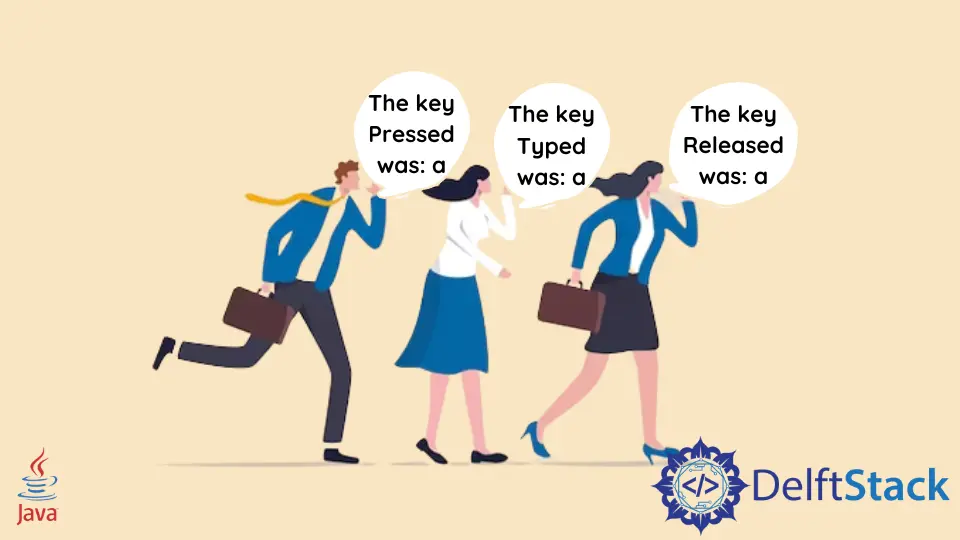在 Java 中使用 KeyListener
Mohammad Irfan
2023年10月12日
Java
Java KeyListener

本教程介绍如何在 Java 中使用 KeyListener 并列出一些示例代码来理解该主题。
KeyListener 是一个处理键盘按键状态变化的接口。正如接口的名称所暗示的那样,它会监听按键并相应地采取行动。
在本教程中,我们将学习如何实现此接口并处理关键事件。
KeyEvent 类
每当按下键盘键时,KeyEvent 类的一个对象就会通知 KeyListener。KeyEvent 类有一些方法可用于获取有关按键事件的更多信息。下面总结了该类中最重要的三个方法。
getKeyChar()方法获取与事件关联的关键字符。如果我们想为特定键添加一些功能,这种方法非常有用。例如,如果按下e,则应用程序应退出。getKeyCode()方法与getKeyChar()方法非常相似。它返回与按下的键相关联的整数键代码。isActionKey()方法可以判断是否按下了操作键(如 Caps Lock)。它返回一个布尔值 true 或 false。
实现 KeyListener 接口
KeyListener 接口监听按键事件并执行一些操作。该接口的声明如下所示。
public interface KeyListener extends EventListener
我们需要在我们的类中重写这个接口的以下三个方法。
keyPressed(KeyEvent e)方法将在按下某个键时被调用。- 释放键时将调用
keyReleased(KeyEvent e)方法。 keyTyped(KeyEvent e)方法将在键键入字符时调用。
我们还将使用 addKeyListener() 方法。我们需要将实现 KeyListener 接口的类的对象传递给该方法。它是一种注册对象以监听和响应关键事件的方式。
KeyListener 的简单应用
让我们创建一个简单的应用程序,它侦听关键事件并向控制台打印一些内容。我们将创建一个框架并为其添加标签。我们的程序应该将关键字符和关键操作打印到控制台。如果按下的键是操作键,则程序应终止。
import java.awt.FlowLayout;
import java.awt.Frame;
import java.awt.Label;
import java.awt.event.KeyEvent;
import java.awt.event.KeyListener;
public class KeyListenerExample implements KeyListener {
@Override
public void keyTyped(KeyEvent e) {
System.out.println("The key Typed was: " + e.getKeyChar());
}
@Override
public void keyPressed(KeyEvent e) {
if (e.isActionKey())
System.exit(0);
System.out.println("The key Pressed was: " + e.getKeyChar());
}
@Override
public void keyReleased(KeyEvent e) {
System.out.println("The key Released was: " + e.getKeyChar());
}
public static void main(String[] args) {
// Setting the Frame and Labels
Frame f = new Frame("Demo");
f.setLayout(new FlowLayout());
f.setSize(500, 500);
Label l = new Label();
l.setText("This is a demonstration");
f.add(l);
f.setVisible(true);
// Creating and adding the key listener
KeyListenerExample k = new KeyListenerExample();
f.addKeyListener(k);
}
}
输出:
The key Pressed was: a
The key Typed was: a
The key Released was: a
The key Pressed was: b
The key Typed was: b
The key Released was: b
使用 KeyListener 的简单游戏应用程序
让我们创建另一个将箭头键作为输入的程序。该程序将根据按下的键将数字 0 移动到矩阵中的不同位置。输出被打印到控制台。
import java.awt.FlowLayout;
import java.awt.Frame;
import java.awt.Label;
import java.awt.event.KeyEvent;
import java.awt.event.KeyListener;
import java.util.Arrays;
public class KeyListenerExample implements KeyListener {
// Matrix and x, y coordinates of 0
int[][] matrix;
int x;
int y;
KeyListenerExample() {
// Initializing the Matrix
matrix = new int[3][3];
matrix[0] = new int[] {1, 1, 1};
matrix[1] = new int[] {1, 0, 1};
matrix[2] = new int[] {1, 1, 1};
x = 1;
y = 1;
// Printing the Matrix
for (int i = 0; i < 3; i++) System.out.println(Arrays.toString(matrix[i]));
System.out.println();
}
// keyPressed() method takes care of moving the zero according to the key pressed
@Override
public void keyPressed(KeyEvent e) {
if (e.getKeyCode() == KeyEvent.VK_RIGHT) {
if (x != 2) {
x += 1;
System.out.println("Moving Right");
} else
System.out.println("Cannot Move Right");
}
if (e.getKeyCode() == KeyEvent.VK_LEFT) {
if (x != 0) {
x -= 1;
System.out.println("Moving Left");
} else
System.out.println("Cannot Move Left");
}
if (e.getKeyCode() == KeyEvent.VK_DOWN) {
if (y != 2) {
y += 1;
System.out.println("Moving Down");
} else
System.out.println("Cannot Move Down");
}
if (e.getKeyCode() == KeyEvent.VK_UP) {
if (y != 0) {
y -= 1;
System.out.println("Moving Up");
} else
System.out.println("Cannot Move Up");
}
matrix[0] = new int[] {1, 1, 1};
matrix[1] = new int[] {1, 1, 1};
matrix[2] = new int[] {1, 1, 1};
matrix[y][x] = 0;
for (int i = 0; i < 3; i++) System.out.println(Arrays.toString(matrix[i]));
System.out.println();
}
// We don't need the other two methods
@Override
public void keyReleased(KeyEvent e) {}
@Override
public void keyTyped(KeyEvent e) {}
public static void main(String[] args) {
// Setting the frame and labels
Frame f = new Frame("Demo");
f.setLayout(new FlowLayout());
f.setSize(200, 200);
Label l = new Label();
l.setText("This is a Game");
f.add(l);
f.setVisible(true);
// Creating and adding the key listener
KeyListenerExample k = new KeyListenerExample();
f.addKeyListener(k);
}
}
输出:
[1, 1, 1]
[1, 0, 1]
[1, 1, 1]
Moving Right
[1, 1, 1]
[1, 1, 0]
[1, 1, 1]
Cannot Move Right
[1, 1, 1]
[1, 1, 0]
[1, 1, 1]
Moving Left
[1, 1, 1]
[1, 0, 1]
[1, 1, 1]
Moving Left
[1, 1, 1]
[0, 1, 1]
[1, 1, 1]
Cannot Move Left
[1, 1, 1]
[0, 1, 1]
[1, 1, 1]
Moving Up
[0, 1, 1]
[1, 1, 1]
[1, 1, 1]
Cannot Move Up
[0, 1, 1]
[1, 1, 1]
[1, 1, 1]
Moving Down
[1, 1, 1]
[0, 1, 1]
[1, 1, 1]
Moving Down
[1, 1, 1]
[1, 1, 1]
[0, 1, 1]
Cannot Move Down
[1, 1, 1]
[1, 1, 1]
[0, 1, 1]
总结
类实现 KeyListener 接口来监听和响应关键事件。在本教程中,我们学习了 KeyEvent 类的一些重要方法。我们还学习了如何实现 KeyListener 接口以及如何覆盖 keyPressed()、keyReleased() 和 keyTyped() 方法。我们还看到了一些演示此接口用法的示例。
Enjoying our tutorials? Subscribe to DelftStack on YouTube to support us in creating more high-quality video guides. Subscribe